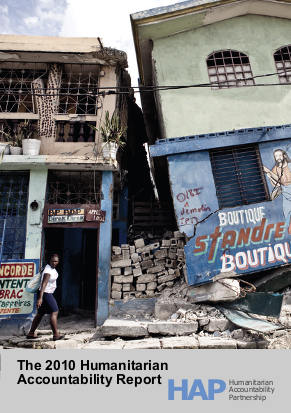
The 2010 Humanitarian Accountability Report contains four chapters, as follows: CHAPTER 1: An Overview of Humanitarian Accountability in 2010. The opening chapter provides an overview of the principal developments and apparent trends in relation to accountability in the humanitarian system. The purpose of the annual humanitarian accountability review is to offer an informed and independent view of progress made by the humanitarian system towards meeting HAP’s vision of a humanitarian system championing the rights and the dignity of disaster survivors. From the materials reviewed, the chapter concludes that there have been some positive developments in 2010—such as “a significant increase in the proportion of evaluations considering accountability to intended beneficiaries and local communities with several evaluation reports making strong calls for strengthened systems of accountability to disaster affected populations” and “evidence that certification against the HAP Standard, validation using the DEC Accountability Framework and UNHCR’s AGDM Strategy can have a positive impact on organisational performance and accountability towards affected populations”. Areas that either did not show progress or which remain of continuing concern are also highlighted. Such areas include: a continued failure to address the issue of too many, inexperienced NGOs being able to access affected populations in high profile emergency responses, and weaknesses in and failures of leadership within the humanitarian system, whether in relation to Humanitarian Coordinators and Cluster Leads or of donors and senior managers not maximising the potential benefits of accountability improvement processes. CHAPTER 2: Perceptions of Humanitarian Accountability—Annual Survey. This chapter reports on the sixth annual survey of perceptions of humanitarian accountability. Based on perceptions of 781 respondents, the 2010 Survey shows a gradual improvement in the accountability deficit—the gap between accountability to intended beneficiaries and to other stakeholder groups—with accountability to intended beneficiaries now perceived as 9 ????????????????being essentially on par with accountability to the general public and host governments. CHAPTER 3: Voices of Disaster Survivors—Haiti 2010. Since 2007, the Humanitarian Accountability Report has presented the views of people with first hand experience of receiving aid, using quotes that typified the sentiments most often expressed to HAP staff during programme-site activities in different countries. The 2010 Report includes a more detailed overview based on focus groups held with 261 survivors of the earthquake that took place in Haiti in January 2010. While the chapter does not claim to represent the range of perspectives of aid recipients in Haiti, it shares some of the issues that were consistently raised during HAP’s deployment in the country and highlights some themes and trends related to the international community’s earthquake response, with particular focus on accountability. CHAPTER 4: HAP Members’ Accountability Work Plan Implementation Reports. This chapter provides a summary of the main activities undertaken by members as they reported them to the HAP Secretariat in their annual Accountability Work Plan Implementation Reports. It also highlights some of the main trends and challenges in HAP members’ efforts to improve humanitarian accountability in 2010, and draws attention to some of the main accountability goals that members will aim to achieve in 2011. Based on a review of reports submitted by 33 members and covering the period 1 January to 31 December 2010, the chapter concludes that “HAP Members’ 2010 Accountability Work Plan Implementation Reports highlight an impressive range of efforts aimed at improving the quality and accountability in humanitarian action and beyond.” Full copies of members’ reports are available on the HAP website.